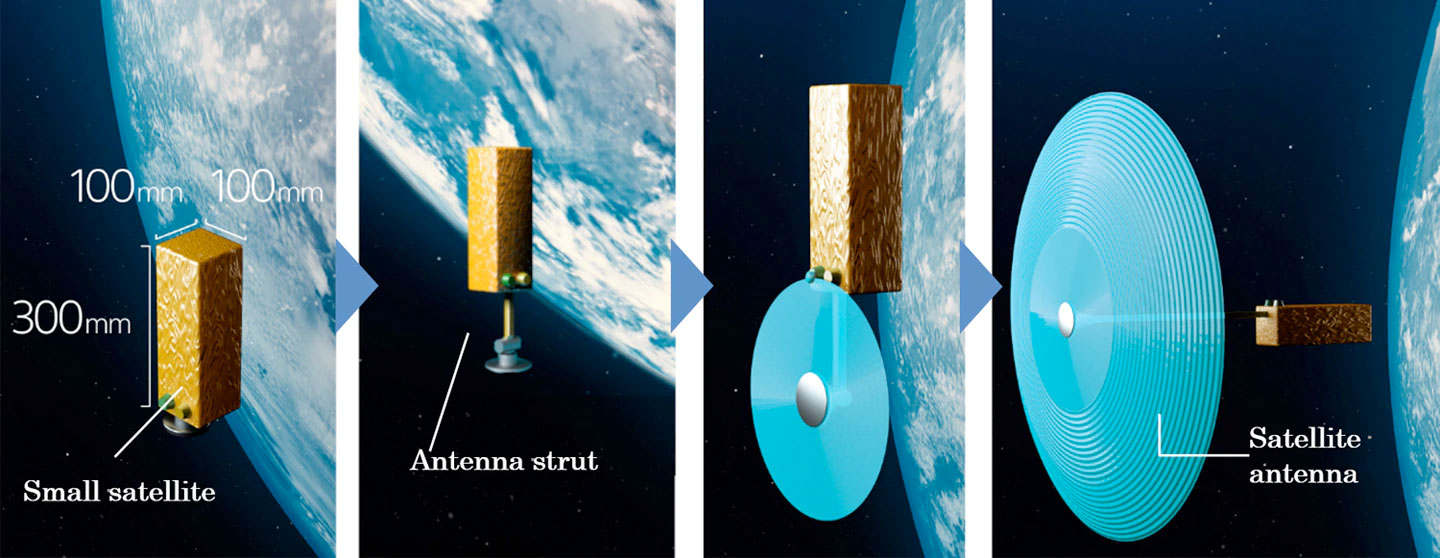Mitsubishi Electric Corporation (Tokyo: 6503) announced that it has developed a space additive manufacturing technology that uses photosensitive resin and ultraviolet light to 3D print satellite antennas in the vacuum of space.
The new technology uses a newly developed liquid resin that is specifically designed to be vacuum stable. The resin enables the structures to be manufactured in space using a low-energy process that uses the sun’s ultraviolet rays for photopolymerization. This technology is specifically designed to meet the challenge of building small, low-cost spacecraft with large structures, such as spacecraft. g. , high-gain antenna reflectors, and enables the fabrication of orbital structures that far exceed the launch vehicle’s aerodynamic dimensions.
Resin-based in-orbit fabrication is expected to allow spacecraft hulls to be made thinner and lighter than conventional designs, which must withstand launch and transition to orbit stresses, affecting both the overall satellite weight and launch costs.
Designing spacecraft antennas is a challenge, not least because of their requirements. It should have high gain, wide bandwidth and low weight. High gain and high bandwidth inevitably require a large aperture, but economic orbital deployment traditionally dictates that designs be light and small enough to fit a launch vehicle or satellite deployment mechanism.
Mitsubishi Electric’s new approach – orbit-based manufacturing – efficiently achieves high-gain, wide-bandwidth, and large-aperture antennas that can be supported by a lightweight, vibration-resistant launcher body. With the development of a 3D printer that extrudes a special UV-curable resin designed for a vacuum, free space resin-based manufacturing with low energy consumption is now possible.
Features
- 3D printer to produce antennas in a vacuum
The 3D printer shares antenna brackets and angle-adjusting motors.
The antenna size is not limited to the aerodynamic size of the launch vehicle or the size of the satellite carrier.
In-orbit fabrication eliminates the need for an antenna structure that can withstand the vibrations and shocks of launch, as required by conventional antenna reflectors.
The weight and thickness of the antenna reflectors are reduced which helps reduce satellite weight and launch costs.
Assuming a 3U CubeSat (100 x 100 x 300 mm), an antenna reflector with a diameter of 165 mm, larger than the size of a CubeSat bus, was fabricated in air and a gain of 23.5 dB in the Ku-band (13.5 GHz) was confirmed. - Photosensitive resin with stability suitable for extrusion and vacuum curing
Commercially available photosensitive resins have a low molecular weight and high vapor pressure and are not suitable for vacuum applications, as they boil and polymerize prematurely. The newly developed UV curing resin uses a high molecular weight, low vapor pressure oligomer base mixed with a vacuum stable plasticizer based on non-volatile polyvinyl ether to achieve a suitable viscosity for vacuum extrusion.
Since most polymerization inhibitors require atmospheric oxygen as a catalyst to prevent premature polymerization and do not operate in a vacuum, the new resin formulation uses polymerization inhibitors that no longer require oxygen and have near-zero volatility.
Upon exposure to UV rays, the resin polymerizes by crosslinking into a solid that is heat-resistant to at least 400°C, which is above the maximum temperature in orbit.
The use of sunlight for polymerization and curing eliminates the need for a separate UV light source, enabling low energy manufacturing.
future developments
Mitsubishi Electric’s in-orbit manufacturing of resin enables small satellites to reach large satellite standards.
This reduces launch costs and allows satellite technology to be used more than ever for applications such as communications and Earth observation. These enhanced capabilities are expected to drive the timely delivery of satellite imagery and monitoring data that meet the diverse needs of individuals and organizations.
Mitsubishi Electric will continue to develop technologies and solutions that help solve global problems in the future.
Find out more about Mitsubishi Electric here.
Don’t miss any other news!
We bring the most important news and information on the topic of 3D printing to your inbox every week for free. Login here.

“Certified tv guru. Reader. Professional writer. Avid introvert. Extreme pop culture buff.”







More Stories
Samsung Quantum Dot TV: Art meets technology
Pitch: €56m for energy startup Reverion
Plastoplan: Plastics for Energy Transition